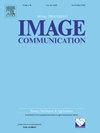使用链码的体素化实体表示算法
IF 2.7
3区 工程技术
Q2 ENGINEERING, ELECTRICAL & ELECTRONIC
引用次数: 0
摘要
本文介绍了一种描述体素固体表面的新方法。它分三个阶段运行:首先创建链码序列的分层链表;链表被修剪;最后,存储数据结构的内容。该方法使用三个或九个符号字母表中的链式代码。在第一种情况下,需要两个链码符号来访问下一个面孔,而在第二种情况下,这是由一个符号完成的。三个符号字母表中的一对链码,或者九个符号字母表中的单个符号都被认为是符号。在这两种情况下,标记集都由两个标记扩展,指示列表的开始和结束。该方法处理任何形状的实体,包括那些包含孔、空腔或存在于同一体素空间中的多个组件的实体。允许边缘连接。将该方法与Lemus等人提出的用于无孔固体的方法进行了比较。虽然支持更广泛的体素化实体集,但所提出的方法生成的令牌序列平均缩短了10%。由于该方法生成的令牌序列的信息熵也较小,因此获得的序列更具可压缩性,应用gzip和bzip2数据压缩器证实了这一点。本文章由计算机程序翻译,如有差异,请以英文原文为准。
An algorithm for voxelised solids representation using chain codes
The paper introduces a new method to describe the surfaces of voxelised solids. It operates in three stages: a hierarchical linked list of chain code sequences is created first; the linked lists are pruned; and, finally, the content of the data structure is stored. The method uses chain codes from either a three- or nine-symbols alphabet. In the first case, two chain code symbols are needed to access the next face, while, in the second case, this is done by one symbol. The pair of chain codes from the three-symbols alphabet, or the individual symbol from the nine-symbols alphabet are considered as tokens. The sets of tokens are, in both cases, extended by two tokens, indicating the beginning and ending of the list. The method processes solids of any shape, including those containing holes, cavities, or multiple components existing in the same voxel space. Edge-connectivity is permitted. The method was compared against the method proposed by Lemus et al., which is designed for solids without holes. Although supporting a broader set of voxelised solids, the proposed method generates sequences of tokens that are, on average, up to 10% shorter. Since the information entropy of the sequences of tokens produced by the proposed method is also smaller, the obtained sequences are more compressible, as confirmed by applying gzip and bzip2 data compressors.
求助全文
通过发布文献求助,成功后即可免费获取论文全文。
去求助
来源期刊

Signal Processing-Image Communication
工程技术-工程:电子与电气
CiteScore
8.40
自引率
2.90%
发文量
138
审稿时长
5.2 months
期刊介绍:
Signal Processing: Image Communication is an international journal for the development of the theory and practice of image communication. Its primary objectives are the following:
To present a forum for the advancement of theory and practice of image communication.
To stimulate cross-fertilization between areas similar in nature which have traditionally been separated, for example, various aspects of visual communications and information systems.
To contribute to a rapid information exchange between the industrial and academic environments.
The editorial policy and the technical content of the journal are the responsibility of the Editor-in-Chief, the Area Editors and the Advisory Editors. The Journal is self-supporting from subscription income and contains a minimum amount of advertisements. Advertisements are subject to the prior approval of the Editor-in-Chief. The journal welcomes contributions from every country in the world.
Signal Processing: Image Communication publishes articles relating to aspects of the design, implementation and use of image communication systems. The journal features original research work, tutorial and review articles, and accounts of practical developments.
Subjects of interest include image/video coding, 3D video representations and compression, 3D graphics and animation compression, HDTV and 3DTV systems, video adaptation, video over IP, peer-to-peer video networking, interactive visual communication, multi-user video conferencing, wireless video broadcasting and communication, visual surveillance, 2D and 3D image/video quality measures, pre/post processing, video restoration and super-resolution, multi-camera video analysis, motion analysis, content-based image/video indexing and retrieval, face and gesture processing, video synthesis, 2D and 3D image/video acquisition and display technologies, architectures for image/video processing and communication.
 求助内容:
求助内容: 应助结果提醒方式:
应助结果提醒方式:


